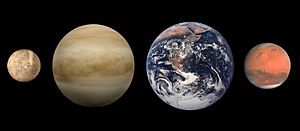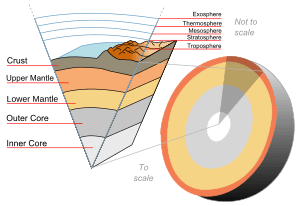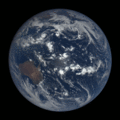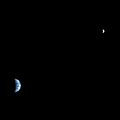Earth facts for kids
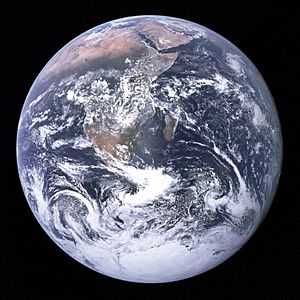
|
|||||||||||||||||
| Designations | |||||||||||||||||
|---|---|---|---|---|---|---|---|---|---|---|---|---|---|---|---|---|---|
| Adjectives | Earthly, terrestrial | ||||||||||||||||
| Orbital characteristics | |||||||||||||||||
| Epoch J2000 | |||||||||||||||||
| Aphelion | 152100000 km (94500000 mi; 1.017 AU) |
||||||||||||||||
| Perihelion | 147095000 km (91401000 mi; 0.98327 AU) |
||||||||||||||||
| 149598023 km (92955902 mi; 1.00000102 AU) |
|||||||||||||||||
| Eccentricity | 0.0167086 | ||||||||||||||||
| 365.256363004 d (1.00001742096 yr) |
|||||||||||||||||
|
Average orbital speed
|
29.78 km/s (107200 km/h; 66600 mph) |
||||||||||||||||
| 358.617° | |||||||||||||||||
| Inclination |
|
||||||||||||||||
| −11.26064° to J2000 ecliptic | |||||||||||||||||
| 114.20783° | |||||||||||||||||
| Satellites |
|
||||||||||||||||
| Physical characteristics | |||||||||||||||||
|
Mean radius
|
6371.0 km (3958.8 mi) | ||||||||||||||||
|
Equatorial radius
|
6378.1 km (3963.2 mi) | ||||||||||||||||
|
Polar radius
|
6356.8 km (3949.9 mi) | ||||||||||||||||
| Flattening | 0.0033528 1/298.257222101 (ETRS89) |
||||||||||||||||
| Circumference |
|
||||||||||||||||
|
|||||||||||||||||
| Volume | 1.08321×1012 km3 (2.59876×1011 cu mi) | ||||||||||||||||
| Mass | 5.97237×1024 kg (1.31668×1025 lb) (3.0×10−6 M☉) |
||||||||||||||||
|
Mean density
|
5.514 g/cm3 (0.1992 lb/cu in) | ||||||||||||||||
| 9.807 m/s2 (1 g; 32.18 ft/s2) | |||||||||||||||||
|
Moment of inertia factor
|
0.3307 | ||||||||||||||||
| 11.186 km/s (40270 km/h; 25020 mph) |
|||||||||||||||||
|
Sidereal rotation period
|
0.99726968 d
(23h 56m 4.100s) |
||||||||||||||||
|
Equatorial rotation velocity
|
0.4651 km/s (1674.4 km/h; 1040.4 mph) |
||||||||||||||||
| 23.4392811° | |||||||||||||||||
| Albedo | |||||||||||||||||
|
|||||||||||||||||
| Atmosphere | |||||||||||||||||
|
Surface pressure
|
101.325 kPa (at MSL) | ||||||||||||||||
| Composition by volume |
|
||||||||||||||||
Earth is a rocky planet and the third planet from the Sun. It is the only planet we know of that has life. Earth formed about 4.5 billion years ago. It is one of four rocky planets in our Solar System. The others are Mercury, Venus, and Mars.
The Sun's huge mass pulls Earth, making it move around the Sun. Earth also spins, so different parts face the Sun at different times. Earth goes around the Sun once (one year) for every 365 and a quarter times it spins (one day).
Earth is special because it has a lot of liquid water. About 74% of Earth's surface is covered by water or ice. This is why people sometimes call it the "blue planet."
Because of its water, Earth is home to millions of species of plants and animals. Living things have greatly changed Earth's surface. For example, early cyanobacteria (tiny living things) changed the air by adding oxygen. The part of Earth's surface where life exists is called the "biosphere".
Contents
What is the Earth's name?
The word Earth comes from an old English word, eorðe. It meant "the ground itself". Like the Roman goddess Terra and Greek goddess Gaia, Earth might have been a goddess in old Germanic stories.
Historically, earth was written with a small 'e'. Later, people started capitalizing nouns, so it became the Earth, especially when talking about other planets. Now, it's often just Earth, like the names of other planets.
How does Earth move in space?
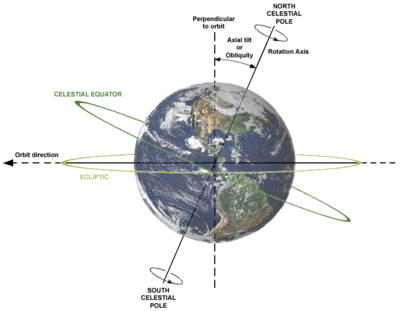
Earth is one of eight planets and many smaller objects that move around the Sun in our Solar System. Our Solar System is currently moving through the Orion Arm of the Milky Way galaxy.
Earth is about 150 million kilometers (93 million miles) away from the Sun. This distance is called an "Astronomical Unit". Earth moves in its orbit at an average speed of about 30 kilometers (18.6 miles) per second. Earth spins completely around about 365 and a quarter times while it goes around the Sun once. To make up for that extra quarter of a day each year, we add an extra day every four years. This is called a "leap year".
The Moon orbits Earth at an average distance of about 400,000 kilometers (250,000 miles). The Moon is "locked" to Earth, meaning the same side always faces us. The other side is sometimes called the "dark side of the moon". It takes about 27 and a third days for the Moon to go around Earth. But because Earth is also moving around the Sun, it takes about 29 and a half days for the Moon to go from new moon to full moon and back again. This is where the word "month" came from.
What is Earth's history?
Earth and the other planets formed about 4.6 billion years ago. They were made from the leftover gas and dust from the cloud that formed the Sun. The Moon might have formed after a huge crash between the early Earth and a smaller planet. Scientists believe parts of both planets broke off and came together to form the Moon due to gravity.
Earth's water came from different places. Water in the early atmosphere cooled and fell as rain, forming the first oceans. Comets and asteroids hitting Earth also brought water. About 3.6 billion years ago, the first life evolved in the oceans. Some bacteria developed photosynthesis, which lets plants make food using sunlight and water. This process released a lot of oxygen. This oxygen first combined with iron in the oceans. Eventually, free oxygen filled the atmosphere, making Earth's surface suitable for life that needs oxygen (called aerobic life). This oxygen also created the ozone layer, which protects Earth's surface from harmful ultraviolet radiation from the Sun. Complex life on land could not exist before the ozone layer formed.
Earth's land and climate have changed a lot over time. About 3 to 3.5 million years ago, almost all the land was joined together in one huge landmass called a supercontinent. The earliest known supercontinent was Vaalbara. Much later, there was a time (the Cryogenian) when Earth was almost completely covered by thick ice sheets (glaciers). This idea is called the Snowball Earth theory.
What is Earth made of?
Earth is a rocky planet. It is the largest rocky planet orbiting the Sun in terms of mass and size. It is much smaller than the gas giants like Jupiter.
What are Earth's main chemicals?
Overall, Earth is made mostly of iron (32.1%), oxygen (30.1%), silicon (15.1%), magnesium (13.9%), sulfur (2.9%), nickel (1.8%), calcium (1.5%), and aluminium (1.4%). The remaining 1.2% is made of many other chemicals.
The inside of Earth has a different chemical makeup than the outside. The center of Earth (Earth's core) is mostly iron (88.8%), nickel (5.8%), and sulfur (4.5%). The Earth's crust (the outer layer) is largely oxygen (47%). Oxygen is usually a gas, but it can combine with other chemicals to form compounds like water and rocks. Most rocks contain oxygen. Common oxygen-containing rocks include silica (with silicon), alumina (with aluminium), rust (with iron), lime (with calcium), and magnesia (with magnesium).
What is Earth's shape?
Earth's shape is not a perfect sphere. It is slightly squashed at the top and bottom and bulges at the middle. This shape is called an oblate spheroid. As Earth spins, centrifugal force pushes the equator out a little and pulls the poles in. The equator, around the middle of Earth, is about 40,075 kilometers (24,901 miles) long.
The highest mountain above sea level is Mount Everest, which is about 8,848 meters (29,030 feet) high. However, it is not the point farthest from Earth's center. That would be the inactive volcano Mount Chimborazo in Ecuador. It is only about 6,263 meters (20,548 feet) above sea level, but it is very close to the equator. Because of the Earth's bulge, Mount Chimborazo is about 6,384 kilometers (3,967 miles) from Earth's center, while Mount Everest is about 2 kilometers (1.2 miles) closer.
Similarly, the lowest known point below sea level is the Challenger Deep in the Mariana Trench in the Pacific Ocean. It is about 10,971 meters (35,994 feet) below sea level. However, there might be places at the bottom of the Arctic Ocean that are actually nearer to the center of the Earth due to the Earth's shape.
What is inside Earth?
The deepest hole ever dug is only about 12.3 kilometers (7.6 miles) deep. We know about Earth's inside by studying earthquakes and volcanoes. We can see how fast shock waves move through Earth's different layers.
The inside of Earth is very different from the outside. Most of Earth's liquid water is in the seas or near the surface. The surface also has a lot of oxygen from plants. Simple life forms can live deep underground, but animals and plants only live on the surface or in the seas.
The rocks on Earth's surface (Earth's crust) are well known. The crust is thicker under land, about 30 to 50 kilometers (19 to 31 miles) thick. Under the seas, it can be as thin as 6 kilometers (3.7 miles). There are three main types of rocks:
- Igneous rocks form when hot liquid rock from inside Earth cools.
- Sedimentary rocks form when sediment (like sand or mud) settles, usually under the sea.
- Metamorphic rocks form when other rocks are changed by very high temperature or pressure.
A few rocks also fall from space, called meteorites.
Below the crust is warm, almost-liquid rock called the Earth's mantle. This mantle is always moving. Below the mantle is a thin liquid layer of very hot rock called the outer core. It is about 7,000°C (12,600°F). The very center of Earth, the inner core, would also be liquid, but the immense weight of the rock above it squeezes it into a solid. This solid inner core is mostly iron. This is what makes Earth magnetic.
How do Earth's plates move?

Earth's crust is solid, but it is broken into large pieces called plates that move very slowly. This hard outer layer rests on the hot, liquid-like material in the deeper mantle. The mantle moves because it gets heat from Earth's hot center. The slow movement of these plates causes earthquakes, volcanoes, and large mountain ranges.
Plates can interact in three main ways:
- Convergent plate edges: Two plates move towards each other. This can form islands (like Japan), volcanoes, and high mountain ranges (like the Andes and Himalayas).
- Divergent plate edges: Two plates move away from each other. This allows hot liquid rock (magma) from inside Earth to come out. This creates underwater mountain ranges or large lowlands like Africa's Great Rift Valley.
- Transform plate edges: Plates slide past each other (like the San Andreas Fault). This causes them to grind against each other, leading to many shocks as they move.
What is Earth's surface like?
Earth's surface is not flat. There are high places like mountains and high flat areas called plateaus. There are also low places like valleys and canyons. Over time, air, water from the sky, and seas wear down rocks in high places, breaking them into small pieces. The air and water then move these pieces to lower places. Without new forces, Earth would have become very flat long ago. The main reason for the differences in Earth's surface is plate tectonics.
All places on Earth are made of, or are on top of, rocks. However, the outer surface is usually not bare rock. Over 70% of Earth is covered by seas full of salty water. This salty water makes up about 97.5% of all Earth's water. The fresh water that people can drink is mostly ice. Only a very small amount is in rivers and underground for people to use. The air above Earth stops water from escaping into outer space.
Much of the land on Earth is covered with plants or the remains of past living things. Places with very little rain are dry areas called deserts. Deserts usually have few living things, but life can grow very quickly when it rains. Places with a lot of rain may be large woods. Recently, people have changed Earth's environment a great deal.
What is Earth's atmosphere like?
Orange labels: known ice ages.
Also see: Human timeline and Nature timeline
All around Earth is a large amount of air, called the atmosphere. Earth's mass pulls the gasses in the air down, keeping them from floating into outer space. The air is mostly made of nitrogen (about 78%) and oxygen (about 21%), with a few other gases. Most living things need air (or parts of the air dissolved in water) to breathe and live. They use gases like oxygen and carbon dioxide to create and use sugar for energy.
The air animals and plants use to live is the lowest layer of the atmosphere, called the troposphere. Daily changes in this layer are called weather. Longer-term changes, or differences between regions, are called climate. Rain and storms happen in this layer. They occur because this part of the air gets colder as it rises. Cold air becomes denser and falls, while warm air becomes lighter and rises. Earth's spin also moves the air. Air moves between the north and south because the middle of Earth generally gets more energy from the Sun and is warmer than the poles. Also, air over water (especially warm water) picks up water vapor. As this air gets colder, it cannot hold as much water, so it forms clouds and rain. This movement of water is called the water cycle.
Above the troposphere, there are four other layers:
- The second layer, the stratosphere, gets warmer as you go up. This layer contains a special type of oxygen called ozone. The ozone protects living things from harmful ultraviolet rays from the Sun. The energy from these rays is what makes this layer warmer.
- The middle layer, the mesosphere, gets colder with height.
- The fourth layer, the thermosphere, gets warmer with height.
- The last layer, the exosphere, is almost outer space and has very little air. It extends about halfway to the Moon.
The three outer layers have a lot of electric energy moving through them. This region is called the ionosphere and is important for radio and other electric waves. It is also where the Northern Lights occur.
Even though air seems very light, the weight of all the air above Earth's surface (air pressure) is important. At sea level, a space of air one cm2 across has a mass of about 1.03 kg. The mass of the air also protects Earth from rocks (meteorites) hitting it from space. Without the air, meteorites would cause much more damage. Because of the air, meteorites usually burn up long before they reach the ground.
The air also helps keep Earth warm, especially the side facing away from the Sun. Some gases, like methane and carbon dioxide, act like a blanket to keep things warm. In the past, Earth has been much warmer and much colder than it is now. Since people have grown used to the current temperatures, we don't want Earth to get too much warmer or colder. Most ways people create electric power involve burning carbon-based fuels like coal, oil, and natural gas. Burning these creates new carbon dioxide, which can cause more warming. There is a big discussion now about what people should do about Earth's recent warming, which has been happening for about 150 years. So far, this warming has had some benefits, like better plant growth. However, some scientists say that many bad things could happen if the warming continues.
Who lives on Earth?
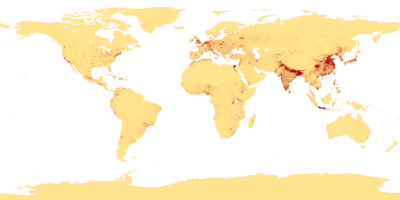
About eight billion people live on Earth. They live in about 200 different places called countries. Some, like Russia, are large with many big cities. Others, like Vatican City, are very small. The five countries with the most people are China, India, the United States, Indonesia, and Brazil. About 90% of people live in the northern half of the world, which has most of the land. Scientists believe that people originally came from Africa. Now, most people (70%) live in Europe and Asia.
People change Earth in many ways. For about ten thousand years, they have been able to grow plants for food and clothes. When there was enough food, they could build towns and cities. In these places, people learned to change rivers, bring water to farms, and stop floods from covering their land. People also found useful animals and tamed them to make them easier to keep.
Related pages
Images for kids
-
Planetary disk around the Sun-like star TW Hydrae; the inner ring has a radius equal to the distance from the Sun to Earth, suggesting an infant version of Earth could be emerging from the dust and gas. The other concentric light and dark features represent other planet-forming regions farther out in the disk.
-
Artist's impression of Earth during the Archean eon, showing falling meteor, erupting volcano, round stromatolites, and barren landscape
-
Global map of heat flow from Earth's interior to the surface
-
Satellite picture of Upsala Glacier, showing mountains, icebergs, lakes, and clouds
-
Illustration of the Earth, Earth's orbit, the Sun and the four seasons
-
Hubble Space Telescope seen in orbit from Space Shuttle Atlantis
-
Processes leading to movements and phase changes in Earth's water
-
Fungi are one of the kingdoms of life on Earth.
-
Tracy Caldwell Dyson in the Cupola module of the International Space Station observing the Earth below
See also
 In Spanish: Tierra para niños
In Spanish: Tierra para niños


